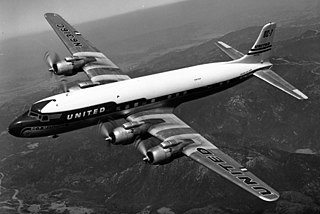
The Douglas DC-7 is an American transport aircraft built by the Douglas Aircraft Company from 1953 to 1958. A derivative of the DC-6, it was the last major piston engine-powered transport made by Douglas, being developed shortly after the earliest jet airliner—the de Havilland Comet—entered service and only a few years before the jet-powered Douglas DC-8 first flew in 1958. Unlike other aircraft in Douglas's line of propeller-driven aircraft, no examples remain in service in the present day, as compared to the far more successful DC-3 and DC-6.
This is a list of aviation-related events from 1974. 1974 had been deemed as “the single worst year in airline history” although this has since been surpassed.
This is a list of aviation-related events from 1976.

USAir Flight 1016 was a regularly scheduled flight in the southeastern United States, between Columbia, South Carolina, and Charlotte, North Carolina. On July 2, 1994, the flight encountered heavy thunderstorms and microburst-induced windshear while attempting to land, and crashed into heavy trees and a private residence near the airport. The crash and ensuing fire caused 37 fatalities and seriously injured twenty others.

The McDonnell Douglas DC-9 is an American five-abreast, single-aisle aircraft designed by the Douglas Aircraft Company. It was initially produced as the Douglas DC-9 prior to August 1967, after which point the company had merged with McDonnell Aircraft to become McDonnell Douglas. Following the introduction of its first jetliner, the high-capacity DC-8, in 1959, Douglas was interested in producing an aircraft suited to smaller routes. As early as 1958, design studies were conducted; approval for the DC-9, a smaller all-new jetliner, came on April 8, 1963. The DC-9-10 first flew on February 25, 1965, and gained its type certificate on November 23, to enter service with Delta Air Lines on December 8.

United Airlines Flight 859 was a Douglas DC-8, registration N8040U, on a scheduled passenger flight that crashed on landing at Stapleton International Airport in Denver, Colorado after departing from Omaha, Nebraska's Eppley Airfield on July 11, 1961. Eighteen people were killed, and 84 were injured.

United Air Lines Flight 608 was a Douglas DC-6 airliner, registration NC37510, on a scheduled passenger flight from Los Angeles to Chicago when it crashed at 12:29 pm on October 24, 1947 about 1.5 miles (2.4 km) southeast of Bryce Canyon Airport, Utah, United States. None of the five crew members and 47 passengers on board survived. It was the first crash of a DC-6, and at the time, it was the second-deadliest air crash in the United States, surpassed by Eastern Air Lines Flight 605 by only one fatality.
Air Ferry Limited was a private, independent British airline operating charter, scheduled and all-cargo flights from 1963 to 1968.

Viasa Flight 742 was an international, scheduled passenger flight from Caracas, Venezuela to Miami International Airport with an intermediate stopover in Maracaibo, Venezuela that crashed on 16 March 1969. After taking off on the Maracaibo to Miami leg, the McDonnell Douglas DC-9-32 hit a series of power lines before crashing into the La Trinidad section of Maracaibo. All 84 people on board perished, as well as 71 on the ground.

The 1961 Derby Aviation crash refers to the fatal crash of a Douglas Dakota IV, registration G-AMSW, operated by Derby Aviation, the forerunner of British Midland Airways, on the mountain of Canigou, France, on 7 October 1961. All 34 on board were killed.

Cubana de Aviación Flight 1216 was a McDonnell Douglas DC-10 that overran the runway at La Aurora International Airport, Guatemala City, on 21 December 1999. 8 passengers and 8 crew members on board were killed as well as 2 people on the ground.
The 1947 Croydon Dakota accident occurred on 25 January 1947 when a Spencer Airways Douglas C-47A Skytrain (Dakota) failed to get airborne from Croydon Airport near London, and crashed into a parked and empty ČSA Douglas C-47 destroying both aircraft and killing 11 passengers and one crew member.

KLM Flight 608 was an international scheduled passenger flight from New York City to Amsterdam. On 23 August 1954, the aircraft crashed in the North Sea off IJmuiden during the Shannon-Amsterdam leg of the flight. The crash killed all 21 passengers and crew on board.









